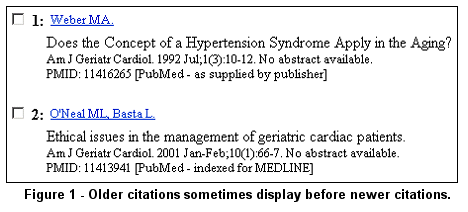| |
 ome users have asked us why citations to older articles sometimes display ahead of newer ones in PubMed. The answer has to do with PubMed's Entrez date and when citations are added to the database.
ome users have asked us why citations to older articles sometimes display ahead of newer ones in PubMed. The answer has to do with PubMed's Entrez date and when citations are added to the database.
Entrez Date
Every record in PubMed (and in all Entrez databases) carries a field known as the Entrez date. The Entrez date is the date the citation was added to PubMed. This field displays on the MEDLINE format as EDAT and does not change over time. In addition to the date, a time is also displayed:
EDAT- 2002/01/11 10:00
Note: Although the EDAT field will not show up on the record for the first 24 hours it is in PubMed, this does not affect the date assigned. The EDAT will reflect the date the citation was added to PubMed.
Display Order
PubMed results are initially displayed in reverse chronological order of the Entrez date, i.e., last in, first out. If desired, search results can be sorted by publication date instead using PubMed's Sort feature. The publication date is the date the article was published and is determined by the journal publisher.
Citations are generally added to PubMed soon after publication. However, there are many instances when citations are not added to PubMed until after the date of publication. This results in older citations receiving an Entrez date that is noticeably more recent than the date of publication.
Citations for older publications can be added to PubMed for the following reasons:
-
When citations from other NLM databases are added to PubMed. This happened four times in 2001 when citations for journal articles from the former AIDSLINE®, SPACELINETM, BIOETHICSLINE®, and HISTLINE® databases were added to MEDLINE®.
-
To fill in gaps in MEDLINE. A gap can be one or more citations to articles in an issue of a journal that was inadvertently not indexed following publication. When we discover the gap, at a later date, we may index these articles.
-
Back issues of a journal are added to PubMed. A journal may be accepted to be indexed for MEDLINE some time after the first issue was published. The publisher can supply citations for dates prior to the MEDLINE acceptance date. (Although these will be added to PubMed, they will not be indexed for MEDLINE.) See the example in Figure 1. Please note the links in this graphic are not active.

The American Journal of Geriatric Cardiology began publication in 1992. NLM started indexing this journal for MEDLINE in 2001. The publisher subsequently submitted back issues to 1992 which appear in PubMed with the "as supplied by publisher" status tag and display in the order of the date they were added to PubMed.
By Annette M. Nahin
MEDLARS Management Section
and
By Sara J. Tybaert
MEDLARS Management Section

Nahin AM, Tybaert SJ. Why Citations to Older Articles May Display Before More Recent Ones in PubMed®. NLM Tech Bull. 2002 Mar-Apr;(325):e3.
| |




 ome users have asked us why citations to older articles sometimes display ahead of newer ones in PubMed. The answer has to do with PubMed's Entrez date and when citations are added to the database.
ome users have asked us why citations to older articles sometimes display ahead of newer ones in PubMed. The answer has to do with PubMed's Entrez date and when citations are added to the database.